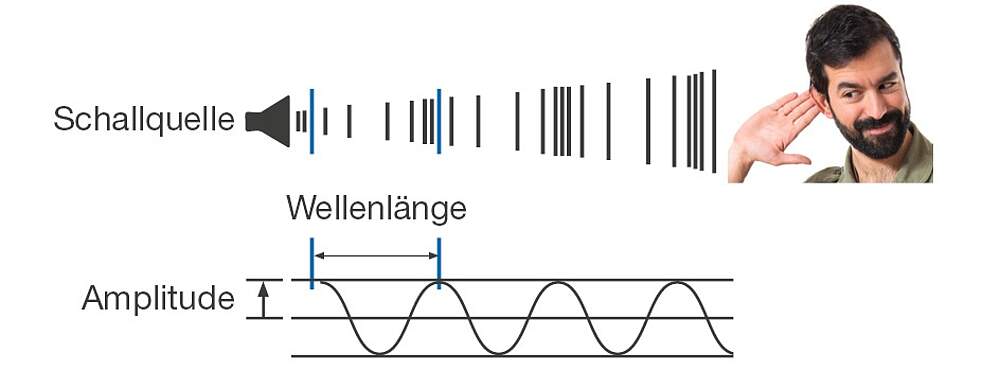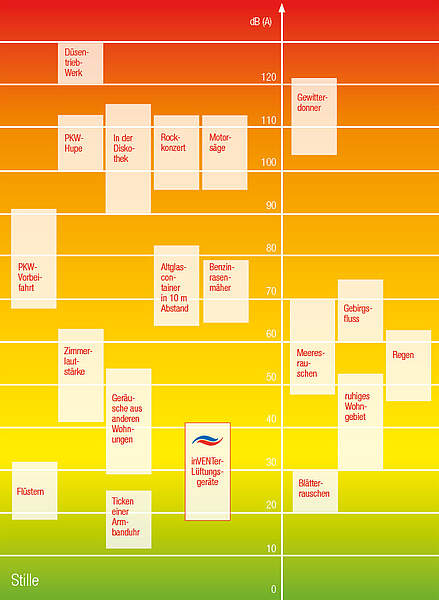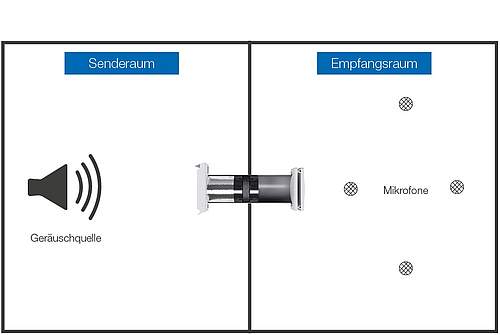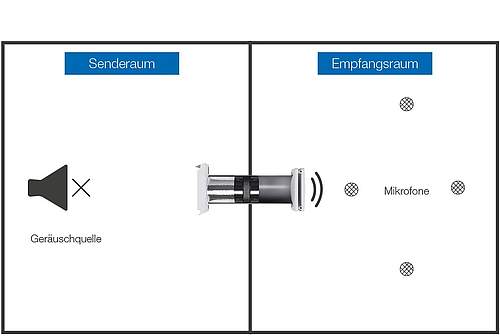Noise development and noise during ventilationBasics and definition of sound
Sound is understood as the wave-like propagating vibration in a gaseous, liquid or solid substance that causes noise. The sound frequency (pitch) denotes the number of vibrations of the sound wave per second, measured in Hertz [Hz]. The human hearing range is between 16 Hz and 20,000 Hz, with the upper frequency range decreasing towards lower frequencies with advancing age. This means that adults tend to perceive high notes more poorly than children. The sound waves with frequencies below 16 Hz that are inaudible to humans are called infrasound, while those with a frequency of over 20,000 Hz are called ultrasound. These are used by various animal species for communication or orientation.
The human ear, as a sensory organ for picking up sounds, not only perceives them as soft or loud, but also as pleasant or unpleasant. In addition to the physical laws, the physiological relationships due to the subjective hearing sensation are important when evaluating noise.
Sound transmission and types of sound
Sound waves cannot propagate in a vacuum, but need a so-called transmission medium whose moving particles can transmit the wave – for example air, water, rock or metal.
“Structure-borne noise” refers to mechanical vibrations that propagate in solid materials. This cannot be perceived directly by the ear, but is emitted by radiation from walls and other surfaces as airborne sound that the human ear can hear. The surface of the body makes the surrounding air vibrate like the membrane of a loudspeaker. Examples of structure-borne noise are: hammering a nail into the wall, dropping objects or climbing stairs (impact sound).
“Airborne sound” is transmitted directly through pressure oscillations in the air, such as when speaking. The sound propagates in the open spherical in all directions and depends on the distance of the sound source, obstacles on the way and the so-called sound reflection, which leads to the creation of an echo.


The hearing can process a sound pressure range from 0.00002 Pa (hearing threshold) to approx. 20 Pa (pain threshold). The human hearing can ignore slow pressure fluctuations, for example due to the difference in height when climbing stairs (several 10 Pa) or when the weather changes. The existing static air pressure has no influence on hearing, because it acts equally on the outside and inside of the eardrum. Pressure equalization can take place during yawning or other jaw movements.
Sound pressure level or noise level
The volume impression does not only depend on the sound pressure, but also on the perception of the human ear. The ear is very sensitive to weak signals; it is much less sensitive to strong signals.
The sound pressure of a tone is a very small absolute value and the scale is very wide. To indicate the strength of the sound, the sound pressure p of a tone is compared with that of a tone that can just be perceived (hearing threshold 1 kHz). The sound pressure level (or sound level) Lp is therefore a relative reference value. The dimensions are given in decibels [dB] on a logarithmic scale. The sound pressure values from 0.00002 Pa to 20 Pa are represented by the decibel values from 0 to 120 dB.
The sound pressure level can be calculated from the sound pressure and the reference sound pressure of 1 kHz using the following formula:

p – effective sound pressure [Pa]
p0 – reference sound pressure [Pa]
The human ear also works roughly logarithmically, the decibel measure of the sound pressure level thus allows a better representation of the volume impression of an acoustic signal. A person cannot perceive differences of less than a decibel. An increase in the sound level by 10 dB is perceived as a possible doubling of the volume. Doubling the distance to the sound source results in a level reduction of approx. 5 dB.
Soundproofing in ventilation
Wind and weather changes affect the air volume flow that flows through a ventilation system. This can sometimes result in perceptible and annoying noises. Noise reduction can be achieved through manual controls or through automated adaptation using suitable accessories.
Noise reduction in ventilation systems
Basically, the higher the air volume flow, the louder the noises that can be caused by a decentralized ventilation system. When the air volume flow is reduced, the flow noises consequently decrease. To achieve this reduction in the air volume flow, there are basically two options:
- - Active adaptation by the user
- - Passive use of accessories to reduce flow noise and air volume flow
inVENTer PAX for high sound insulation
inVENTer PAX sound insulation ventilators are barely audible and offer a solution when there is an increased need for sound insulation, for example in buildings exposed to wind or buildings with thin walls.
“Here in northern Germany we always had the problem that the strong north wind caused the fans of our ventilation systems to overdrive. You could also hear that acoustically. With the new inVENTer PAX, we finally have a solution for all affected residential units on the coastal region. ” – Olaf Elbinger

Measurement method for standard sound level difference and sound power
Relationship between sound power and sound power level
The radiated sound power [P] of a noise source per unit of time is given in watts and generally describes the power of the sound source. It can be determined by measuring the sound pressure at several points in a closed room. From the sound pressure level at a certain distance from the sound source, its sound power or, for a given sound power, the sound pressure level at a certain distance can be calculated.
Calculation of the sound power:

I – sound intensity
A – reference area
The sound power [P] is a variable that is independent of distance and room and is suitable as a starting point for all sound engineering calculations. The sound power level [Lw] is the logarithmic representation of the sound power and, in practice, the common quantity.

P – sound power [watt]
P0 – reference sound power [watt]
Calculating with sound pressure levels
Sound pressure level values must not simply be added up. Only the sound power (or sound intensity) of two sound sources, which is proportional to the square of the sound pressure, is added. To double the sound power, the sound pressure only needs to be increased by a factor of √2. A conversion to the sound pressure level is then possible.
The following relationships apply:
The doubling of the sound power leads to an increase in the sound level of 3 dB:
- - 20∙log(√2) = 3,01
The tenfold increase in the sound power leads to an increase in the sound level by 10 dB:
- - 20∙log(√10) = 10
If two sound sources with Lw = 0 dB each are added, the result is
- - 0 dB + 0 dB = 3 dB

Adding two sound sources with 65 dB each results in
- - 65 dB + 65 dB = 68 dB
Doubling the sound pressure results in an increase of 6 dB:
- - 20∙log(2) = 6,02
Doubling of the sound pressure with an output of Lp = 40 dB:
- - 40 dB + 40 dB = 46 dB
Measurement method standard sound level difference
The standard sound level difference is a measured variable for characterizing the airborne sound insulation of a component and is frequency-dependent. Here, the ability of the component to provide sound insulation between two rooms is measured. The value indicates the sound pressure difference between the generator room and the receiving room (measured in dB).
The experimental setup for measuring the standard sound level difference is as follows: A noise of 100 dB is generated in the transmission room while the fan is off. The noise is transmitted to the reception room through the switched off ventilation. There, the microphones are used to measure how many dB the sound reaches the reception room through the ventilation.

Calculation equation:
Lp1 – mean sound pressure level in the sending room [dB]
Lp2 – mean sound pressure level in the receiving room [dB]
A0 – reference absorption area [m2]
A – equivalent absorption area in the reception room [m2]
T – reverberation time [s]
V – room volume (receiving room) [m3]
Measurement method sound power
The total sound energy that is radiated from a sound source per second is the sound power [P]. It cannot be measured directly, but can only be determined using certain measuring methods. A sound source has a constant sound power that does not change when it radiates (emits) into another room environment.
The experimental setup for measuring the sound power is carried out as follows: The noise source is off, the fan is on. It’s quiet in the sending room, but the fan is making a noise in the receiving room. The microphones measure how much of the noise from the ventilation reaches the reception room.

Calculation equation:
Lw – sound power of the examined sound source [dB]
Lp – mean Sound pressure level – background noise correction [dB]
T – reverberation time of the reverberation room [s]
T0 – reference time 1s
V – reverberation room volume [m3]
V0 – reference volume 1 m3
λ – wavelength [m]
S – total surface of the reverberation room
B – barometric pressure [bar]


